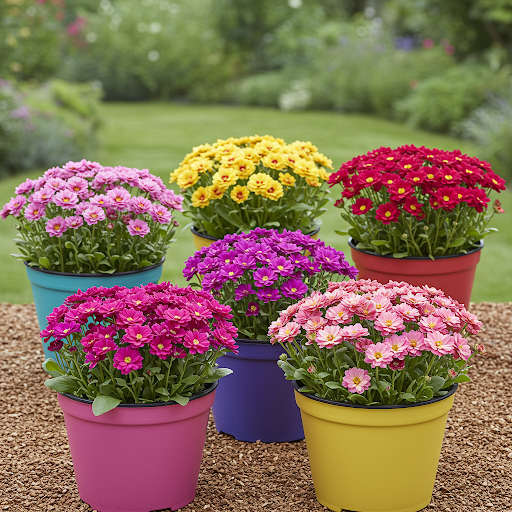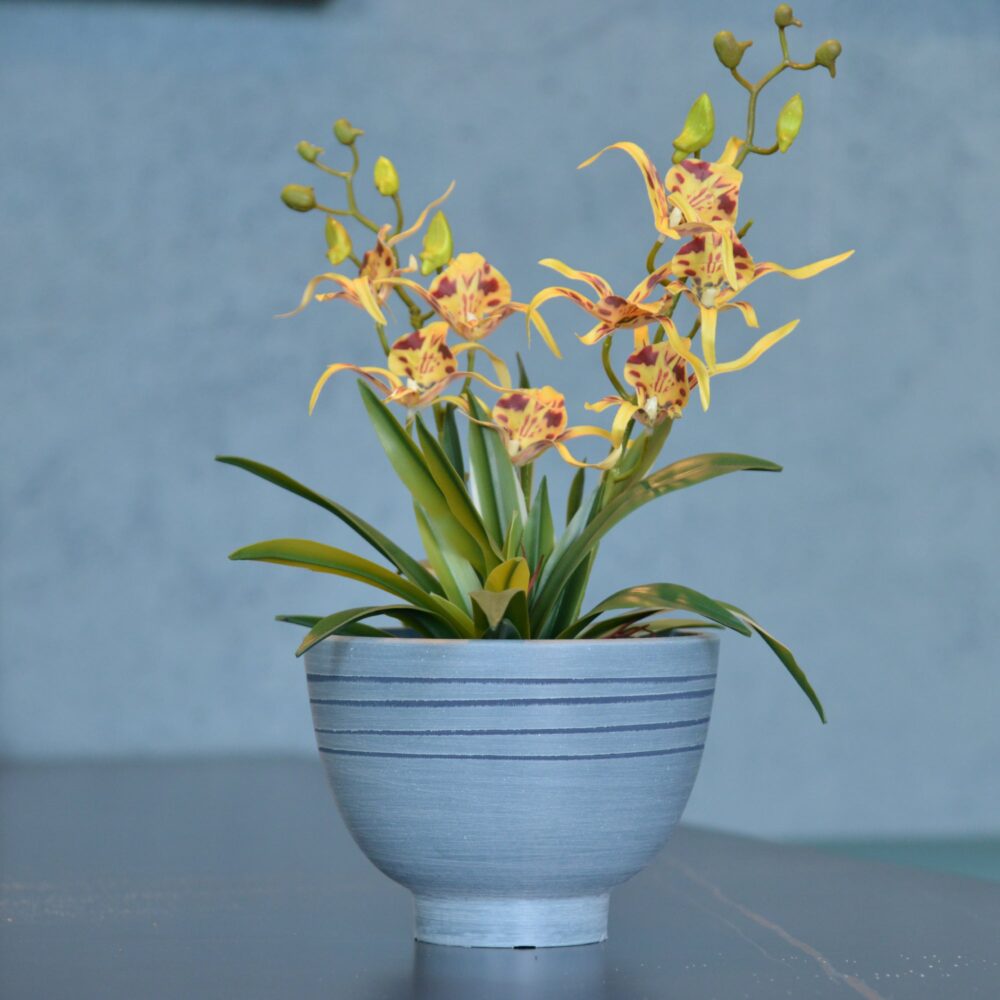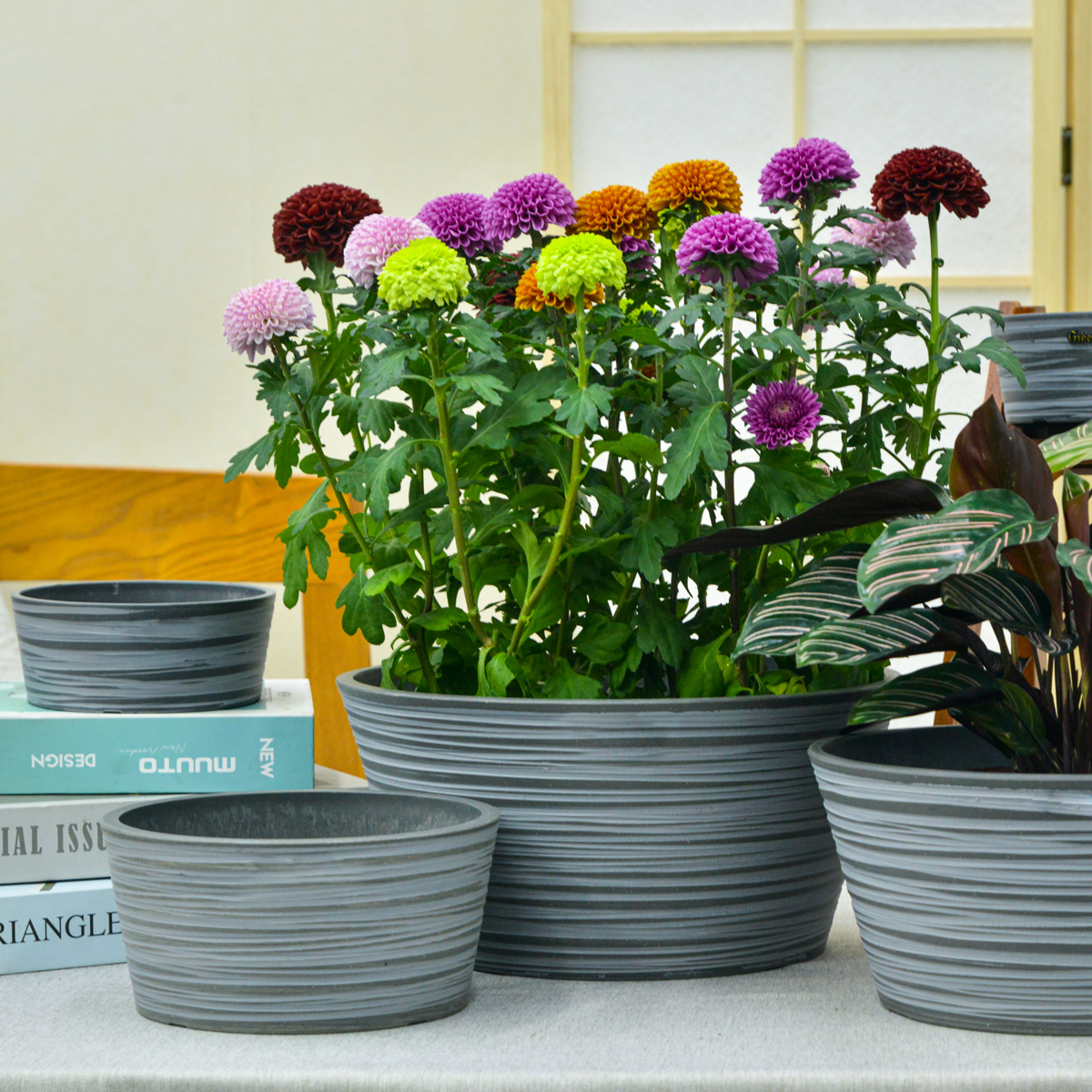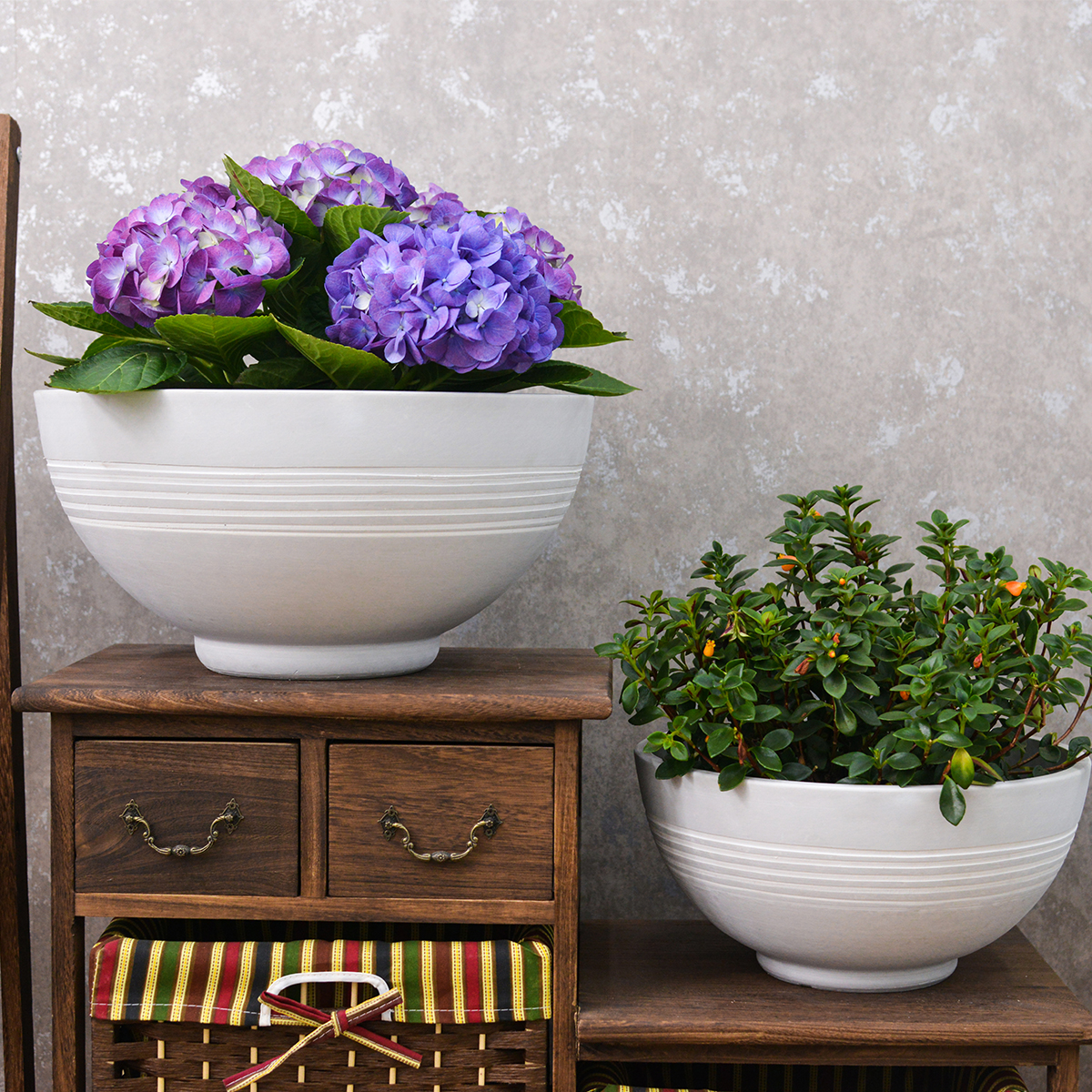Salpiglossis in Pots: The Complete Guide to Growing Painted Tongue Outdoors in Containers
Want to add a touch of exotic elegance and velvety texture to your patio, balcony, or garden? Salpiglossis sinuata, commonly known as Painted Tongue or Scalloped Tube Tongue, are wonderfully unique and rewarding choices for outdoor container gardening. Celebrated for their trumpet-shaped, velvety flowers with striking veining patterns, their jewel-toned colors ranging from rich purples and blues to reds, oranges, yellows, and bi-colors, and their intriguing, sophisticated appearance, Salpiglossis are perfect for adding a touch of artistry and refinement to sunny outdoor spaces. This comprehensive guide will provide you with everything you need to know to grow Salpiglossis successfully in outdoor pots, from selecting the best varieties and containers to mastering essential care techniques for a season filled with Painted Tongue blooms and painterly charm.

Salpiglossis
What are Salpiglossis (Painted Tongue)?
Salpiglossis sinuata, commonly called Painted Tongue or Scalloped Tube Tongue, is an annual flowering plant in the Solanaceae family (nightshade family), which also includes petunias and tomatoes. Native to southern South America, specifically Chile, Salpiglossis sinuata are popular annuals grown for their uniquely patterned, trumpet-shaped flowers and velvety texture. Salpiglossis flowers are famous for their intricate veining patterns that resemble brushstrokes or painted designs, giving them the common name “Painted Tongue”. They come in a jewel-toned array of colors, including purple, violet, blue, crimson, red, orange, yellow, gold, and bi-colors, often with contrasting veins in gold, yellow, or contrasting shades. Salpiglossis plants are characterized by their upright, branching growth habit, slightly sticky, lance-shaped leaves, and delicate, velvety flower petals. They exhibit an upright, bushy growth habit, typically reaching 1 to 3 feet in height, depending on the cultivar and series. They are known for their unique flower patterns, velvety texture, jewel-toned colors, sophisticated appearance, and relative ease of care, making them an invaluable addition to gardens and containers, especially for adding a touch of artistic flair and cut-flower elegance.
Are Salpiglossis Good for Outdoor Pots?
Yes, Salpiglossis sinuata are well-suited for outdoor pots and container gardening, especially compact and medium-sized varieties. Their upright, bushy growth habit, relatively long blooming season, tolerance of sunny locations and moderate temperatures, and uniquely patterned, velvety flowers make them ideal for filling pots, patio containers, and mixed container arrangements for sunny to partially sunny locations. Salpiglossis thrive in full sun to partial shade and bloom from summer into fall, providing a distinctive and delightful display in containers. Their relatively easy-care nature and artistic blooms make them a fantastic and rewarding choice for container gardens of all styles, especially for adding a touch of sophistication, cottage garden charm, or cut-flower interest to patios, balconies, and decks. Growing Salpiglossisin pots also allows you to easily move them to optimal locations to enjoy their beauty, to follow the sun, and to provide some protection from intense afternoon heat in hotter climates.
Ideal Growing Conditions for Salpiglossis in Pots:
Types of Salpiglossis for Pots: Many Salpiglossis sinuata varieties and series are excellent for pots, but consider your desired height, flower color, and bloom time when choosing:
- Compact Salpiglossis: (Under 1.5 feet tall) – Compact and smaller in stature, ideal for small to medium pots, window boxes, edging, and foreground plantings. Known for their more compact, bushy habit and profusion of blooms on shorter stems. Excellent for smaller containers and tighter spaces. Look for series like ‘Kew Blue’, ‘Chocolate Royale’, ‘Bolero Mix’, and dwarf selections of standard series.
- Medium-Sized Salpiglossis: (1.5-2.5 feet tall) – Bushy and more upright than dwarf types, but still relatively compact, suitable for medium to large pots, patio containers, and mixed arrangements. Offer larger flowers and a wider range of colors in a manageable size for pots. Look for series like ‘Royale Series’, ‘Superbissima Series’, ‘Select Mixed’, ‘Splash Series’, and ‘Rhapsody Series’. These are versatile for pots.
- Taller Salpiglossis: (Over 2.5 feet tall) – More upright and taller, best suited for larger pots, as thrillers in mixed containers, and for back-of-border placements in large containers. Offer a more dramatic vertical presence and larger flower heads in containers. Look for older heirloom varieties or taller selections within mixed series. Taller types may need staking in pots, especially in windy locations. For most container gardening, dwarf to medium types are more practical.
- Color Themes (for Pots): Choose varieties based on your desired color palette for your container garden. Salpiglossis offer a jewel-toned and warm color range.
- Purples & Blues: ‘Kew Blue’, ‘Royal Purple’, ‘Blue Velvet’, ‘Lavender Shades’, ‘Purple Bicolor’, ‘Deep Blue’.
- Reds & Crimsons: ‘Crimson Bicolor’, ‘Scarlet Glow’, ‘Mahogany Red’, ‘Wine Red’, ‘Burgundy’, ‘Velvet Red’.
- Oranges & Golds: ‘Golden Yellow’, ‘Apricot Shades’, ‘Orange Bicolor’, ‘Gold Veined’, ‘Sunset Orange’, ‘Apricot with Gold Veins’.
- Yellows & Creams: ‘Lemon Yellow’, ‘Cream Shades’, ‘Pale Yellow’, ‘Ivory Veined’, ‘Vanilla Cream’, ‘Pastel Yellow’.
- Bi-colors & Mixes: ‘Bolero Mix’ (mixed compact colors), ‘Royale Mixed’ (mixed jewel tones), ‘Splash Mix’ (spotted and veined mix), ‘Harlequin Mix’ (bi-color and patterned mix), ‘Carnival Mix’ (bright mixed colors).
Light: Salpiglossis thrive in full sun to partial shade. They need at least 6 hours of direct sunlight per day to bloom well, but in hotter climates, they appreciate some afternoon shade to protect their delicate flowers from scorching in intense heat. Ideal locations are east-facing patios or balconies that receive morning sun and afternoon shade, or south-facing locations with filtered afternoon sun. In full sun, especially in hot summer areas, provide some protection during the hottest part of the day. In partial shade, Salpiglossis will still bloom, but may produce slightly fewer flowers and become a bit leggier. Aim for morning sun and afternoon shade for best results, especially in warmer zones.
Soil: Salpiglossis need well-draining soil that is moderately fertile and slightly acidic to neutral. Use a high-quality potting mix specifically formulated for containers or flowers. Amend potting mix with perlite, vermiculite, or horticultural grit to improve drainage and aeration, which is important for Salpiglossis to prevent root rot. While they appreciate consistent moisture, they dislike soggy soil. Avoid heavy, compacted soil or garden soil in pots, as they can become waterlogged. A slightly acidic to neutral pH (around 6.0-7.0) is ideal for Salpiglossis.
Watering: Salpiglossis need consistently moist soil, but they also need excellent drainage and dislike being waterlogged. Water thoroughly when the top inch of soil feels slightly dry. Water deeply until water drains out of the drainage holes. Allow the soil surface to dry out slightly between waterings, but do not let the soil dry out completely, especially during hot weather or when plants are in bud or bloom. Avoid overwatering and constantly soggy soil, which can lead to root rot. Salpiglossis prefer a “moist but not soggy” soil environment. Watering frequency will depend on weather conditions, light levels, pot size, and plant size. During hot summer months, you may need to water more frequently, especially for smaller pots in full sun or windy locations. Check soil moisture regularly and adjust watering accordingly. Water at the base of the plant or use gentle overhead watering early in the day to allow foliage and flowers to dry before evening, which can help prevent fungal diseases.
Temperature: Salpiglossis are cool-season annuals that thrive in mild temperatures. They perform best in temperatures between 60°F to 75°F (15°C to 24°C). They bloom most prolifically in spring and fall when temperatures are moderate. Hot summer temperatures (above 85°F/29°C) can cause them to slow down or temporarily stop blooming, especially in hot summer climates. In very hot summer areas, provide afternoon shade. Salpiglossis are frost-tender and are not cold-hardy. They are typically grown as annuals in most climates (USDA zones below 9). In USDA zones 9-10, Salpiglossis may survive as short-lived biennials or very tender perennialsin mild, frost-free conditions, but are still generally grown as annuals for best, most reliable performance and consistent blooms. Potted Salpiglossis are easy to move to optimal locations to enjoy their beauty and provide protection from temperature extremes. They do not tolerate frost or freezing temperatures.
Fertilizer: Salpiglossis are moderate feeders and benefit from regular fertilization to support their blooming and healthy growth. Consistent fertilization encourages continuous flowering. Fertilize regularly during the growing season (spring to fall) with a balanced liquid fertilizer (e.g., 10-10-10 or 20-20-20) diluted to half strength, every 2-3 weeks, or according to product label instructions. For containers, more frequent feeding (e.g., every 3 weeks) may be beneficial due to leaching from watering. Alternatively, you can use a slow-release granular fertilizerincorporated into the potting mix at planting time, but supplement with liquid feed throughout the season, especially for heavy bloomers. Choose a fertilizer formulated for flowering plants, or a balanced fertilizer. Regular, consistent feeding is beneficial for Salpiglossis to fuel their continuous blooming. Avoid high-nitrogen fertilizers, which can promote leafy growth at the expense of blooms.
Choosing the Right Pots for Salpiglossis:
Suitable Pot Types: Salpiglossis are adaptable to various pot types, including terracotta, ceramic, plastic, resin, and decorative containers. Consider these factors when selecting pot types for Salpiglossis:
- Terracotta Pots: Porous, allow good aeration and drainage, and aesthetically classic and warm-toned, complementing Salpiglossis‘s velvety blooms and sophisticated charm. Terracotta is a good choice for Salpiglossis as it provides good drainage and a classic look. However, terracotta pots also dry out more quickly, which may require more frequent watering, especially in sunny, warm locations. Monitor soil moisture closely.
- Glazed Ceramic Pots: Available in many decorative styles, can add a decorative element to your container garden, and retain moisture reasonably well. Ensure good drainage. Choose based on your desired aesthetic and moisture retention needs. Glazed ceramic pots retain moisture better than unglazed terracotta, which can be beneficial for Salpiglossis, but ensure drainage is still adequate. Choose colors and styles that enhance the jewel-toned flowers.
- Plastic Pots: Lightweight, inexpensive, retain moisture well, and are available in various colors and styles. Excellent choice for Salpiglossis, especially for moisture retention and for larger pots that need to be moved. Choose good quality plastic pots with drainage holes. Plastic pots help retain moisture, which can be beneficial, especially in sunny locations and for busy gardeners.
- Resin Pots: Lightweight, durable, available in various styles mimicking terracotta or ceramic, and offer a balance of drainage and moisture retention. A good alternative to heavy ceramic pots, and often more durable than terracotta or plastic. Resin pots also retain moisture well, similar to plastic.
- Decorative Containers: Salpiglossis‘s elegant and artistic flowers lend themselves well to decorative containers that enhance their sophisticated beauty. Choose pots with interesting shapes, textures, or colors that complement the jewel tones of the blooms.
Drainage: Excellent drainage is essential for Salpiglossis to prevent root rot. They are susceptible to root rot in soggy conditions. Ensure your chosen pot has drainage holes at the bottom. Avoid pots without drainage holes. Adding a generous layer of perlite or pot shards at the base of the pot is highly recommended to further improve drainage, especially in heavier pots or if you tend to overwater. Elevating pots slightly on pot feet or bricks can further improve drainage and air circulation around the base.
Pot Size: Choose pot sizes appropriate for the type and mature size of the Salpiglossis you are planting, and the desired visual impact. Salpiglossis have moderately sized root systems and need adequate space for healthy growth and flowering.
- Compact Salpiglossis: For compact Salpiglossis varieties, pots that are 6-8 inches in diameter and at least 8 inches deep are suitable for individual plants. For mass plantings or window boxes, use larger containers or window boxes with spacing of about 8-10 inches between plants.
- Medium-Sized Salpiglossis: For medium-sized Salpiglossis varieties, use pots that are 8-12 inches in diameter or larger and at least 10 inches deep for individual plants, or larger patio containers for multiple plants or mixed arrangements. Medium-sized Salpiglossis need more root space and stability.
- Taller Salpiglossis: For taller Salpiglossis varieties, use pots that are 12-16 inches in diameter or larger and at least 12 inches deep to accommodate their larger root systems and top growth. Taller types may also benefit from wider pots for stability, especially if staking is not used.
Color and Style: Choose pot colors and styles that complement your Salpiglossis blooms and your outdoor décor, and enhance their elegant, artistic nature. Solid colored pots in neutral tones like terracotta, gray, black, or white can provide a sophisticated backdrop that allows the jewel-toned flowers and their veining patterns to truly shine. Jewel-toned pots in deep blues, purples, greens, or metallics can echo and enhance the flower colors, creating a rich, harmonious look. Ornate or decorative pots with intricate patterns or classic shapes can further enhance the sophisticated and artistic feel of Salpiglossis. Consider the overall style of your patio or garden and choose pots that harmonize with the surroundings, and enhance the elegant, painterly ambiance you wish to create.
Essential Care Tips for Thriving Salpiglossis in Outdoor Pots:
- Watering: “Keep Soil Consistently Moist, Allow Surface to Dry Slightly, Avoid Soggy Soil”. Water thoroughly and regularly to maintain consistently moist soil, especially during warm weather and active blooming. Water deeply when the top inch of soil feels slightly dry. Allow the soil surface to dry slightly between waterings. Avoid overwatering and constantly soggy soil. Consistent moisture is key, but drainage is equally important.
- Sunlight: Provide Full Sun to Partial Shade (Morning Sun & Afternoon Shade Ideal). Place Salpiglossis pots in a location that receives full sun to partial shade, with protection from intense afternoon heat, especially in hotter climates. Morning sun and afternoon shade is ideal.
- Fertilizing: Fertilize Regularly, Every 2-3 Weeks During Growing Season. Fertilize every 2-3 weeks with a dilute balanced liquid fertilizer, or use slow-release fertilizer supplemented with liquid feed. Regular, consistent feeding is beneficial for prolific blooming.
- Deadheading (Encourage Continuous Bloom & Tidiness): Deadhead spent flower heads regularly to encourage continuous blooming and maintain a tidy appearance. Pinch or snip off faded flowers below the flower head. Regular deadheading encourages more flower production throughout the season.
- Staking (For Taller Varieties, Optional): Taller Salpiglossis varieties may benefit from staking, especially in windy locations or if grown in very fertile soil which can lead to softer growth. Use bamboo stakes or plant supports to gently support taller stems and prevent them from flopping over. Staking is optional, but can help maintain a neater appearance for taller types in pots.
- Pinching (Encourage Bushier Growth, Optional): Pinch back young Salpiglossis seedlings when they are young to encourage bushier growth and more flower stems. Pinch off the tips of stems when plants are young to promote branching if desired. Pinching is optional, but can result in fuller, bushier plants with even more blooms.
- Cool Temperatures (Prolong Bloom Season): Salpiglossis bloom best in cool to moderate temperatures. In hot summer climates, provide afternoon shade and try to locate pots in a slightly cooler spot to prolong their bloom season.
- Pest and Disease Control: Salpiglossis are generally relatively pest and disease-resistant, but monitor for occasional pests like aphids and spider mites. Fungal diseases like powdery mildew and root rot can occur if conditions are too humid or soil is kept too soggy. Ensure good air circulation by spacing plants adequately, avoid overcrowding, provide excellent drainage, and avoid overwatering. Treat any pest or disease issues promptly with insecticidal soap, horticultural oil, neem oil, or appropriate fungicides if necessary.
Popular Salpiglossis Cultivars for Pots (by Series/Color/Size):
- Royale Series (Selecta One): Medium height, large, showy flowers, jewel-toned colors, good for pots and cut flowers. ‘Royale Purple Bicolor’, ‘Royale Crimson Bicolor’, ‘Royale Blue Bicolor’, ‘Royale Orange Bicolor’, ‘Royale Yellow Bicolor’, ‘Royale Mixed’.
- Superbissima Series (Benary): Medium to tall height, very large flowers, classic Salpiglossis form, rich colors. ‘Superbissima Mixed’, ‘Superbissima Purple’, ‘Superbissima Red’, ‘Superbissima Yellow’, and other Superbissima selections.
- Kew Blue (Heirloom): Compact, dwarf, unique smoky blue-purple flowers with gold veins, excellent for smaller pots and window boxes. Classic heirloom variety.
- Chocolate Royale (Selecta One): Compact, dwarf, unique chocolate-burgundy flowers with gold veins, rich and unusual color. Good for pots and combinations.
- Bolero Mix (PanAmerican Seed): Dwarf, very compact mix of colors, early blooming, tight habit, ideal for small pots and mass plantings. ‘Bolero Mixed’, ‘Bolero Blue’, ‘Bolero Yellow’, ‘Bolero Orange’, and other Bolero colors.
- Splash Series (Goldsmith Seeds): Medium height, spotted and veined flowers, unique patterns, adds interest to pots. ‘Splash Mixed’, ‘Splash Blue’, ‘Splash Red’, ‘Splash Yellow’, and other Splash colors.
- Rhapsody Series (Thompson & Morgan): Medium height, good color range, reliable and versatile for pots. ‘Rhapsody Mixed’, ‘Rhapsody Blue’, ‘Rhapsody Red’, ‘Rhapsody Yellow’, and other Rhapsody colors.
In Summary:
Growing Salpiglossis sinuata (Painted Tongue) in outdoor pots is a wonderfully rewarding way to add a touch of exotic elegance and velvety texture to your patios, balconies, and gardens. Their uniquely patterned, trumpet-shaped flowers, jewel-toned colors, sophisticated appearance, and relative ease of care make them a perfect choice for container gardeners seeking artistic and refined blooms. By providing full sun to partial shade, well-draining potting mix in pots with excellent drainage, consistent moisture but avoiding soggy soil, regular fertilizing during the growing season, deadheading spent flowers, and choosing pot sizes and styles that enhance their painterly beauty, you can easily cultivate thriving Salpiglossis plants in pots and enjoy their captivating, colorful displays from summer until frost, year after year as annuals.

Salpiglossis
For more detailed botanical information and to explore the diverse world of Salpiglossis, you can visit the Wikipedia page on Salpiglossis.
Important Note: Salpiglossis sinuata plants are generally considered non-toxic to humans and pets, making them a safe and attractive choice for households with children and animals. The primary care benefits of Salpiglossis in pots are their uniquely patterned and velvety flowers, jewel-toned and sophisticated color range, elegant appearance, and relatively easy care, bringing artistic flair and refined beauty to your outdoor spaces for many months. With these simple care practices, you can enjoy a season filled with the delightful charm of Salpiglossis in your outdoor containers.
8 inch/10 inch Planter Indoor Plants, 2 Pack Modern Decorative Plant Pots with Drainage Hole, Cute Bowl Shape Flower Pots
By greenship-seo|2025-04-10T08:03:42+00:00January 9, 2025|Categories: Hand-carving Series|Tags: Decorative Flower Pots, Self-Watering Pots|
k2-21G
By greenship|2024-08-13T06:17:26+00:00August 13, 2024|Categories: Hand-carving Series|
11THD
By greenship|2024-08-13T02:52:20+00:00August 13, 2024|Categories: Hand-carving Series|
KC3-09k
By greenship|2024-08-16T06:24:36+00:00August 16, 2024|Categories: Hand-carving Series|
Modern Plant Pots丨Planter for Indoor Plants,8 inch or 10 inch Plant Pots with Drainage Hole,Decorative Flower Pots
By greenship-seo|2025-04-10T08:32:55+00:00January 7, 2025|Categories: Hand-carving Series|Tags: Decorative Flower Pots, Self-Watering Pots|
KC2-11V
By greenship|2024-08-16T05:39:50+00:00August 16, 2024|Categories: Hand-carving Series|






